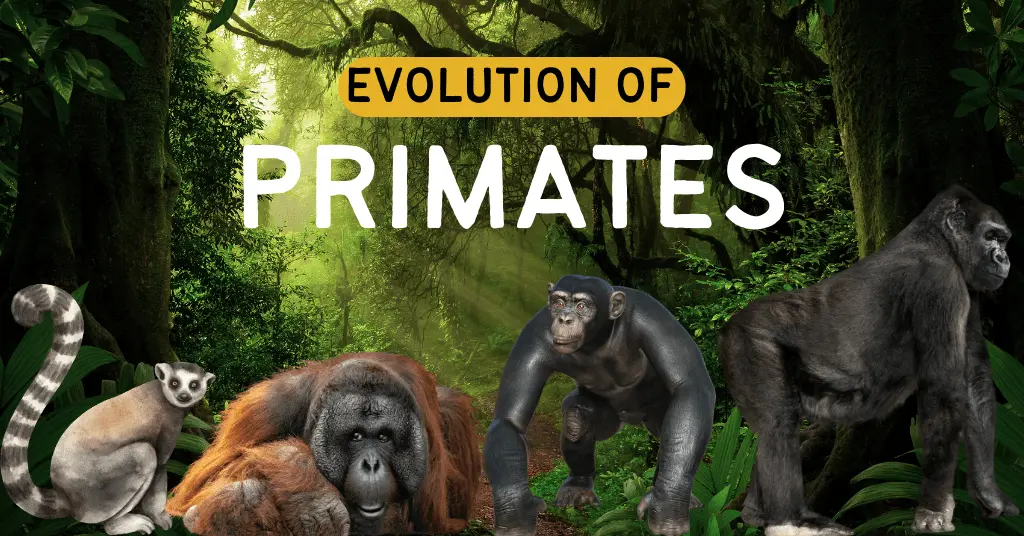AI Answer Evaluation Platform Live Now. Try Free Answer Evaluation Now
Evolution of Primates
Primates are an order of mammals that includes humans, apes, monkeys, and prosimians such as lemurs, lorises, and tarsiers. Understanding the evolution of primates is crucial for understanding human origins, as well as the origins of our closest living relatives.

Early Evolution of Primates
Origins of primates
The origins of primates can be traced back to the Paleocene epoch (66-56 million years ago) with the emergence of plesiadapiforms. These early primate-like mammals possessed some characteristics similar to modern primates, such as an arboreal lifestyle and grasping hands, but lacked other features like stereoscopic vision. The Eocene epoch (56-33.9 million years ago) saw the rise of the first true primates, which were better adapted to life in the trees.
Adaptations to arboreal life
Early primates developed various adaptations to help them survive in their arboreal habitats. Some of these key adaptations include:
- Grasping hands and feet: Primates possess opposable thumbs and big toes, which allow them to grip branches securely.
- Stereoscopic vision: Primates have forward-facing eyes with overlapping fields of vision, providing depth perception and better spatial awareness.
Major primate groups
Primates can be divided into two major groups: Strepsirrhines and Haplorhines. Strepsirrhines include lemurs, lorises, and galagos, while Haplorhines encompass tarsiers, monkeys, apes, and humans.
| Suborder | Infraorder | Family | Example Species |
|---|---|---|---|
| Strepsirrhini | Lemuriformes | Lemuridae | Ring-tailed lemur (Lemur catta) |
| Strepsirrhini | Lemuriformes | Indriidae | Indri (Indri indri) |
| Strepsirrhini | Chiromyiformes | Daubentoniidae | Aye-aye (Daubentonia madagascariensis) |
| Strepsirrhini | Lorisiformes | Lorisidae | Slow loris (Nycticebus spp.) |
| Strepsirrhini | Lorisiformes | Galagidae | Bushbaby (Galago spp.) |
| Haplorrhini | Tarsiiformes | Tarsiidae | Tarsier (Tarsius spp.) |
| Haplorrhini | Simiiformes | Cebidae | Capuchin monkey (Cebus spp.) |
| Haplorrhini | Simiiformes | Atelidae | Howler monkey (Alouatta spp.) |
| Haplorrhini | Simiiformes | Callitrichidae | Marmoset (Callithrix spp.) |
| Haplorrhini | Simiiformes | Cercopithecidae | Baboon (Papio spp.) |
| Haplorrhini | Simiiformes | Colobinae | Colobus monkey (Colobus spp.) |
| Haplorrhini | Simiiformes | Hylobatidae | Gibbon (Hylobates spp.) |
| Haplorrhini | Simiiformes | Hominidae | Orangutan (Pongo spp.) |
| Haplorrhini | Simiiformes | Hominidae | Gorilla (Gorilla spp.) |
| Haplorrhini | Simiiformes | Hominidae | Chimpanzee (Pan troglodytes) |
| Haplorrhini | Simiiformes | Hominidae | Human (Homo sapiens) |
Prosimians: The First Primates
Definition and characteristics of prosimians: Prosimians are considered the most primitive of primates and are characterized by their reliance on olfactory senses, grooming claws, and a tooth comb. They are predominantly nocturnal and arboreal, with some exceptions such as the diurnal lemurs of Madagascar.
Diversity of prosimians
Prosimians can be further divided into three main groups:
- Lemurs: Found exclusively on Madagascar, lemurs display a wide range of body sizes, ecological niches, and social systems. Examples include the ring-tailed lemur (Lemur catta) and the critically endangered black-and-white ruffed lemur (Varecia variegata).
- Lorises: Found in Southeast Asia and Africa, lorises are characterized by their slow, deliberate movements and potent venomous bite. Examples include the slow loris (Nycticebus spp.) and the slender loris (Loris tardigradus).
- Galagos (bushbabies): Small, nocturnal primates found in Africa, galagos are known for their large eyes and incredible leaping abilities. Examples include the lesser bushbaby (Galago senegalensis) and the greater bushbaby (Otolemur crassicaudatus).
Fossil evidence and biogeography
Fossil evidence of early prosimians dates back to the Eocene epoch, with the most ancient fossils found in North America, Europe, and Asia. The subsequent continental drift led to the isolation and diversification of prosimians in Madagascar and Africa.
Role in primate evolution
Prosimians provide valuable insights into the early evolution of primates, as they retain many ancestral traits that were present in the common ancestor of all primates.
Anthropoids: The Emergence of Monkeys
Definition and characteristics of anthropoids: Anthropoids, also known as simians, are primates that include both New World and Old World monkeys, as well as apes and humans. They are characterized by a reduced reliance on olfactory senses, fused mandibles, and larger brain size relative to body size compared to prosimians.
Early anthropoids
The early anthropoids, which first appeared during the Eocene epoch, can be divided into two groups:
- Eosimiids: These small, arboreal primates from Asia are considered the earliest true anthropoids. Fossils of Eosimias, a representative genus, date back to around 45 million years ago.
- Parapithecids: An early group of anthropoids from the Oligocene epoch (33.9-23 million years ago) that inhabited Africa. Their dental and cranial features indicate a close relationship to later anthropoids.
New World monkeys
New World monkeys, also known as platyrrhines, are found in Central and South America. They have flat, broad noses with nostrils facing sideways, and many species possess prehensile tails. Major families and species include:
- Callitrichidae: Marmosets and tamarins, such as the common marmoset (Callithrix jacchus) and the golden lion tamarin (Leontopithecus rosalia)
- Cebidae: Capuchins and squirrel monkeys, such as the white-faced capuchin (Cebus capucinus) and the common squirrel monkey (Saimiri sciureus)
- Atelidae: Howler monkeys, spider monkeys, and woolly monkeys, such as the red howler monkey (Alouatta seniculus) and the black-handed spider monkey (Ateles geoffroyi)
Old World monkeys
Old World monkeys, also known as catarrhines, are found in Africa and Asia. They have narrow, downward-facing nostrils and generally lack prehensile tails. Major families and species include:
- Cercopithecidae: Baboons, macaques, and guenons, such as the olive baboon (Papio anubis), the rhesus macaque (Macaca mulatta), and the red-tailed guenon (Cercopithecus ascanius)
- Colobinae: Colobus monkeys and langurs, such as the black-and-white colobus (Colobus guereza) and the Hanuman langur (Semnopithecus entellus)
Apes: Our Closest Relatives
Definition and characteristics of apes: Apes are a group of primates that lack tails and have more flexible shoulder joints than monkeys, allowing for greater freedom of movement in the trees. They also have a larger brain-to-body size ratio and exhibit more complex social behaviors compared to monkeys.
Lesser apes: gibbons and siamangs
Lesser apes, which include gibbons and siamangs, are found in Southeast Asia. They are known for their incredible agility in the trees and their distinctive, melodious songs. Taxonomically, they belong to the family Hylobatidae, which has four genera and 20 species. Gibbons and siamangs exhibit monogamous social systems and are primarily frugivorous.
Great apes: orangutans, gorillas, and chimpanzees
Great apes are the largest and most cognitively advanced of all primates, and include orangutans, gorillas, and chimpanzees, as well as humans. Some key features of great apes include their larger body size, complex social behavior, and advanced problem-solving abilities.
- Orangutans: Found in the rainforests of Borneo and Sumatra, orangutans (Pongo spp.) are the most arboreal of the great apes. They are known for their intelligence and ability to use tools, such as sticks for insect extraction. Orangutans exhibit a semi-solitary social structure and face severe threats from habitat loss and the illegal pet trade.
- Gorillas: Gorillas (Gorilla spp.) are the largest primates and are native to the forests of central Africa. They live in social groups led by a dominant male, known as a silverback. Gorillas are primarily herbivorous, with a diet consisting mainly of leaves, stems, and fruit.
- Chimpanzees: Chimpanzees (Pan troglodytes) are native to the forests of central and west Africa. They live in complex, multi-male, multi-female social groups and are known for their sophisticated tool use, such as using sticks to fish for termites. Chimpanzees are also known for their cultural behaviors, with different populations exhibiting unique traditions and customs.
Hominids: The Rise of the Human Lineage
Hominid evolution
The hominid lineage, which includes humans and our closest extinct relatives, began to diverge from the lineage of chimpanzees around 6-7 million years ago. Some key early hominid species include:
- Sahelanthropus tchadensis: Dating back to around 7 million years ago, Sahelanthropus is one of the earliest known hominids. Fossils from this species show a mix of ape-like and human-like features, such as a smaller braincase and a more vertically-oriented face.
- Ardipithecus: This genus, which lived around 4.4 million years ago, includes species like Ardipithecus ramidus, which possessed both arboreal and bipedal adaptations. Ardipithecus provides crucial insights into the early stages of hominid evolution and the emergence of bipedalism.
- Australopithecus: This genus lived between 4 and 2 million years ago and includes several species, such as Australopithecus afarensis (“Lucy”) and Australopithecus africanus. These hominids were bipedal but retained many primitive features, such as a small brain and large canine teeth.
Homo genus
The Homo genus, which includes modern humans, emerged around 2 million years ago. Some key species within the Homo genus include:
- Homo habilis: Known as the “handy man,” Homo habilis lived around 2.1 to 1.5 million years ago and is the earliest known member of the Homo genus. They were the first hominids to use stone tools, known as Oldowan tools, and had a larger brain size compared to earlier hominids.
- Homo erectus: Living from around 1.9 million to 100,000 years ago, Homo erectus was the first hominid to migrate out of Africa and into Eurasia. They had a larger brain size and more human-like body proportions compared to Homo habilis. They were also skilled hunters and tool-makers, developing the more advanced Acheulean tool tradition.
- Homo neanderthalensis: Neanderthals lived in Europe and western Asia between 400,000 and 40,000 years ago. They had a robust body structure and a larger brain size compared to modern humans. They were skilled hunters, used complex tools, and even practiced burial rituals.
Homo sapiens
Anatomically modern humans (Homo sapiens) first appeared around 300,000 years ago in Africa. They were characterized by a more slender body structure, a larger brain capacity, and a flatter face compared to earlier hominids.
- Behavioral modernity: The emergence of complex language, art, and symbolic thought in Homo sapiens around 50,000 years ago marked the beginning of behavioral modernity. This development allowed for the rapid cultural evolution and technological innovation that set our species apart from other hominids.
Primate Social Behavior and Cognition
Social structures and group living
Primates exhibit a diverse range of social structures, from solitary individuals to large, multi-male, multi-female groups. Social structures can be influenced by factors such as resource availability, predation pressure, and mating systems. For example, gorillas live in cohesive groups led by a single dominant male, while chimpanzees form large, fluid communities with multiple males and females.
Communication and vocalizations
Primates use a variety of vocalizations and body language to communicate with one another. Some examples include alarm calls, which warn group members of potential threats, and food calls, which signal the discovery of a food source. Primates can also communicate through facial expressions, gestures, and tactile behaviors such as grooming.
Tool use and problem-solving
Many primates exhibit remarkable problem-solving abilities and can use tools to accomplish tasks. For example, chimpanzees are known to use sticks to fish for termites and stones to crack open nuts, while capuchin monkeys use stones to crack open hard-shelled fruits.
Cultural behaviors and learning
Primates are capable of learning from one another and can pass on learned behaviors to future generations. This cultural transmission has been observed in various primate species, with different populations exhibiting unique traditions and customs. For example, different chimpanzee communities have distinct tool-using techniques and grooming rituals.
Theory of mind and empathy
Theory of mind refers to the ability to attribute mental states to oneself and others, allowing for an understanding of others’ emotions and intentions. Some primates, such as chimpanzees and orangutans, have been shown to possess a basic understanding of theory of mind. Additionally, many primates exhibit empathy and have been observed consoling distressed group members through physical contact or grooming.
Conservation and the Future of Primates
Threats to primate populations
Primate populations are facing numerous threats, including:
- Habitat loss and fragmentation: Deforestation and land conversion for agriculture, logging, and infrastructure development are leading to the loss and fragmentation of primate habitats.
- Hunting and bushmeat trade: Many primate species are hunted for their meat or captured for the illegal pet trade, leading to a decline in their populations.
- Disease: Primates are susceptible to various diseases, some of which can be transmitted from humans, posing a significant threat to their populations.
Conservation efforts
Efforts to conserve primate populations include:
- Protected areas: Establishing and managing protected areas, such as national parks and wildlife reserves, can help preserve primate habitats and protect their populations.
- Community-based conservation: Engaging local communities in conservation efforts, such as ecotourism and sustainable resource management, can help promote the long-term survival of primate populations.
- Captive breeding and reintroduction programs: Breeding endangered primates in captivity and reintroducing them to the wild can help bolster their populations and promote genetic diversity.
The role of primatology in conservation
Primatologists play a crucial role in primate conservation by studying primate behavior, ecology, and genetics. This research helps to inform conservation strategies and develop effective management plans to protect these remarkable animals and their habitats.
Conclusion
Understanding the evolution of primates sheds light on the shared history of humans and our closest living relatives. From the early beginnings of primate evolution to the rise of the human lineage, the diverse adaptations and behaviors of primates offer fascinating insights into our own origins and the complex social and cognitive abilities that define us.
The study of primate evolution also underscores the importance of conserving these remarkable animals and their habitats. As human activities increasingly threaten primate populations, it is crucial that we work to protect these species and ensure their survival for future generations. By learning more about primates, their evolutionary history, and their unique behaviors, we can better appreciate the intricate connections between humans and our primate cousins, and deepen our commitment to their conservation.



